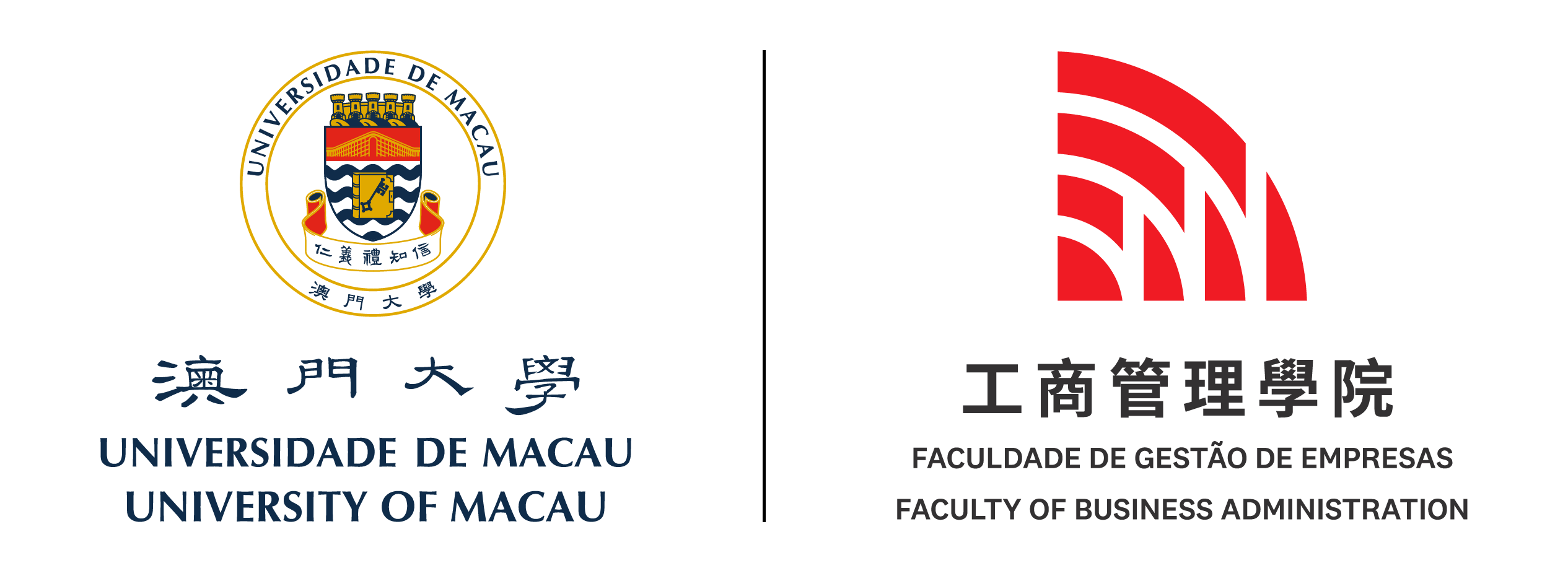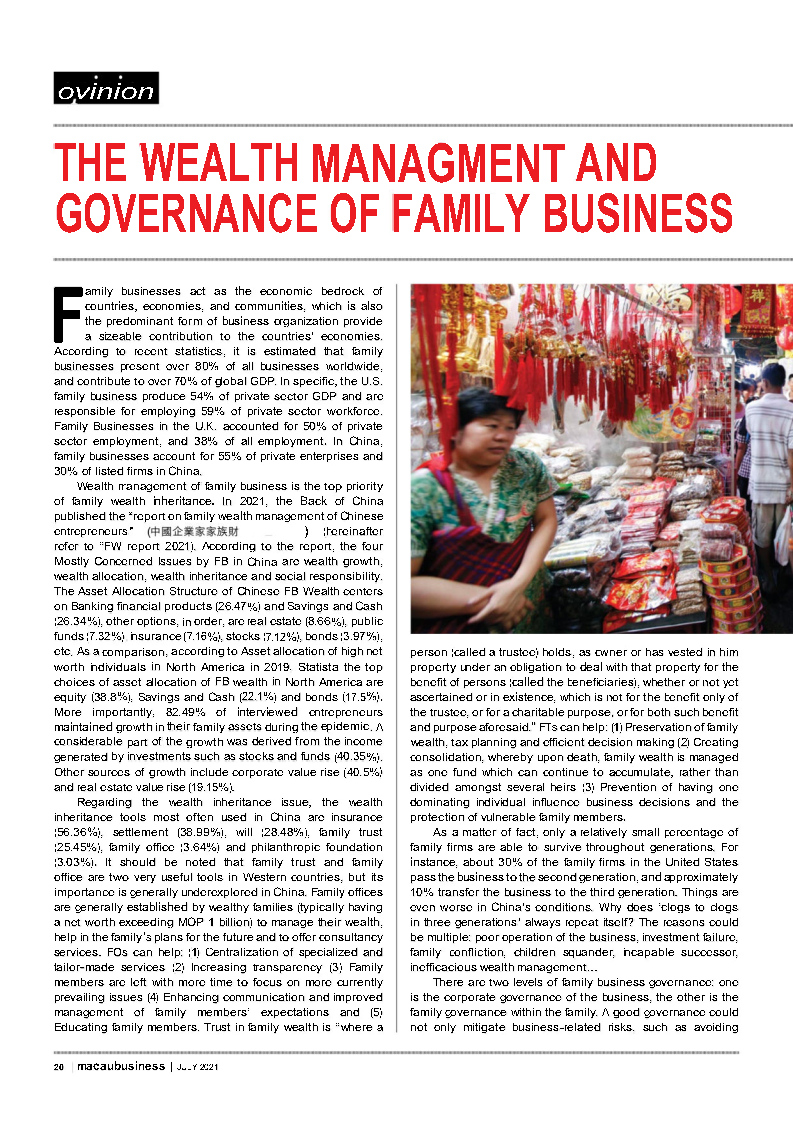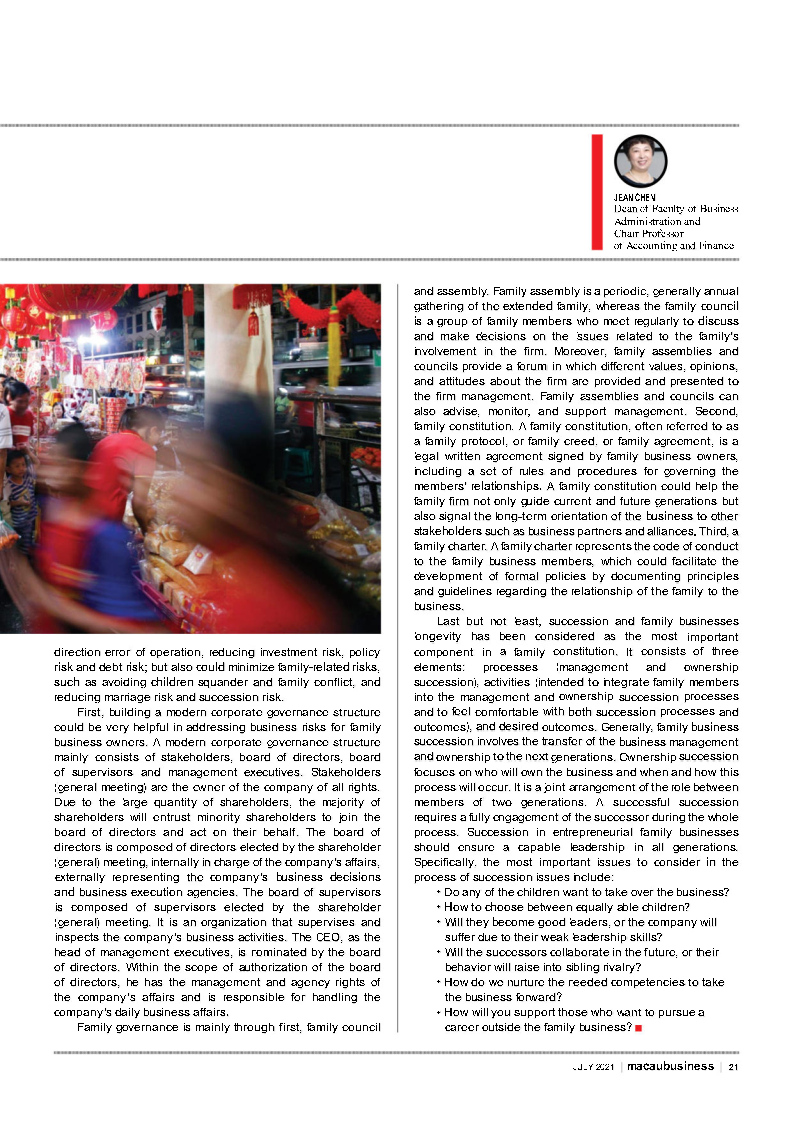Family businesses act as the economic bedrock of countries, economies, and communities, which is also the predominant form of business organization provide a sizeable contribution to the countries’ economies. According to recent statistics, it is estimated that family businesses present over 80% of all businesses worldwide, and contribute to over 70% of global GDP. In specific, the U.S. family business produce 54% of private sector GDP and are responsible for employing 59% of private sector workforce. Family Businesses in the U.K. accounted for 50% of private sector employment, and 38% of all employment. In China, family businesses account for 55% of private enterprises and 30% of listed firms in China.
Wealth management of family business is the top priority of family wealth inheritance. In 2021, the Back of China published the “report on family wealth management of Chinese entrepreneurs” (中國企業家族財富管理白皮書) (hereinafter refer to “FW report 2021). According to the report, the four Mostly Concerned Issues by FB in China are wealth growth, wealth allocation, wealth inheritance and social responsibility. The Asset Allocation Structure of Chinese FB Wealth centers on Banking financial products (26.47%) and Savings and Cash (26.34%), other options, in order, are real estate (8.66%), public funds (7.32%) insurance (7.16%), stocks (7.12%), bonds (3.97%), etc. As a comparison, according to Asset allocation of high net worth individuals in North America in 2019, Statista the top choices of asset allocation of FB wealth in North America are equity (38.8%), Savings and Cash (22.1%) and bonds (17.5%). More importantly, 82.49% of interviewed entrepreneurs maintained growth in their family assets during the epidemic. A considerable part of the growth was derived from the income generated by investments such as stocks and funds (40.35%). Other sources of growth include corporate value rise (40.5%) and real estate value rise (19.15%).
Regarding the wealth inheritance issue, the wealth inheritance tools most often used in China are insurance (56.36%), settlement (38.99%), will (28.48%), family trust (25.45%), family office (3.64%) and philanthropic foundation (3.03%). It should be noted that family trust and family office are two very useful tools in Western countries, but its importance is generally underexplored in China. Family offices are generally established by wealthy families (typically having a net worth exceeding MOP 1 billion) to manage their wealth, help in the family’s plans for the future and to offer consultancy services. FOs can help: (1) Centralization of specialized and tailor-made services (2) Increasing transparency (3) Family members are left with more time to focus on more currently prevailing issues (4) Enhancing communication and improved management of family members’ expectations and (5) Educating family members. Trust in family wealth is “where a person (called a trustee) holds, as owner or has vested in him property under an obligation to deal with that property for the benefit of persons (called the beneficiaries), whether or not yet ascertained or in existence, which is not for the benefit only of the trustee, or for a charitable purpose, or for both such benefit and purpose aforesaid.” FTs can help: (1) Preservation of family wealth, tax planning and efficient decision making (2) Creating consolidation, whereby upon death, family wealth is managed as one fund which can continue to accumulate, rather than divided amongst several heirs (3) Prevention of having one dominating individual influence business decisions and the protection of vulnerable family members.
As a matter of fact, only a relatively small percentage of family firms are able to survive throughout generations. For instance, about 30% of the family firms in the United States pass the business to the second generation, and approximately 10% transfer the business to the third generation. Things are even worse in China’s conditions. Why does ‘clogs to clogs in three generations’ always repeat itself? The reasons could be multiple: poor operation of the business, investment failure, family confliction, children squander, incapable successor, inefficacious wealth management…
There are two levels of family business governance: one is the corporate governance of the business, the other is the family governance within the family. A good governance could not only mitigate business-related risks, such as avoiding direction error of operation, reducing investment risk, policy risk and debt risk; but also could minimize family-related risks, such as avoiding children squander and family conflict, and reducing marriage risk and succession risk.
First, building a modern corporate governance structure could be very helpful in addressing business risks for family business owners. A modern corporate governance structure mainly consists of stakeholders, board of directors, board of supervisors and management executives. Stakeholders (general meeting) are the owner of the company of all rights. Due to the large quantity of shareholders, the majority of shareholders will entrust minority shareholders to join the board of directors and act on their behalf. The board of directors is composed of directors elected by the shareholder (general) meeting, internally in charge of the company’s affairs, externally representing the company’s business decisions and business execution agencies. The board of supervisors is composed of supervisors elected by the shareholder (general) meeting. It is an organization that supervises and inspects the company’s business activities. The CEO, as the head of management executives, is nominated by the board of directors. Within the scope of authorization of the board of directors, he has the management and agency rights of the company’s affairs and is responsible for handling the company’s daily business affairs.
Family governance is mainly through first, family council and assembly. Family assembly is a periodic, generally annual gathering of the extended family, whereas the family council is a group of family members who meet regularly to discuss and make decisions on the issues related to the family’s involvement in the firm. Moreover, family assemblies and councils provide a forum in which different values, opinions, and attitudes about the firm are provided and presented to the firm management. Family assemblies and councils can also advise, monitor, and support management. Second, family constitution. A family constitution, often referred to as a family protocol, or family creed, or family agreement, is a legal written agreement signed by family business owners, including a set of rules and procedures for governing the members’ relationships. A family constitution could help the family firm not only guide current and future generations but also signal the long-term orientation of the business to other stakeholders such as business partners and alliances. Third, a family charter. A family charter represents the code of conduct to the family business members, which could facilitate the development of formal policies by documenting principles and guidelines regarding the relationship of the family to the business.
Last but not least, succession and family businesses longevity has been considered as the most important component in a family constitution. It consists of three elements: processes (management and ownership succession), activities (intended to integrate family members into the management and ownership succession processes and to feel comfortable with both succession processes and outcomes), and desired outcomes. Generally, family business succession involves the transfer of the business management and ownership to the next generations. Ownership succession focuses on who will own the business and when and how this process will occur. It is a joint arrangement of the role between members of two generations. A successful succession requires a fully engagement of the successor during the whole process. Succession in entrepreneurial family businesses should ensure a capable leadership in all generations. Specifically, the most important issues to consider in the process of succession issues include:
• Do any of the children want to take over the business?
• How to choose between equally able children?
• Will they become good leaders, or the company will suffer due to their weak leadership skills?
• Will the successors collaborate in the future, or their behavior will raise into sibling rivalry?
• How do we nurture the needed competencies to take the business forward?
• How will you support those who want to pursue a career outside the family business?
(Source: Macau Business Media)



